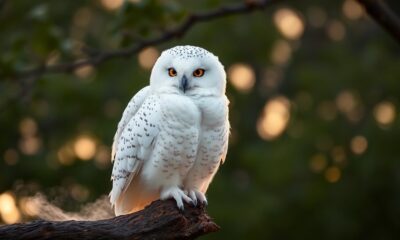Symbolism
White Owl Symbol: The Mystical Emblem of Wisdom and Protection!
Journey into the enchanting world of the white owl, a mystical emblem of wisdom and protection, and discover what secrets it holds.

The white owl is a potent symbol of wisdom and protection, serving as a guide during personal transformations. When you spot a white owl, it often signifies intuitive insights and spiritual awakening. Their cultural interpretations vary, often linking them to insight in Greek mythology or spiritual messages in Native American traditions. They encourage adaptability, inviting you to embrace change with open arms. Whether in dreams or folklore, they're seen as guardians of knowledge. If you're curious about the deeper meanings and connections of the white owl, there's much more to uncover about this mystical creature and its significance.
Key Takeaways
- White owls symbolize personal transformation, offering intuitive guidance and clarity during significant life changes.
- In various cultures, they represent wisdom, serving as spiritual messengers and omens of good fortune.
- Their pristine feathers signify spiritual purity and renewal, encouraging adaptability and trust in the transformation process.
- White owls inspire introspection, inviting individuals to confront fears and embrace new beginnings with an open heart.
- While associated with wisdom and protection, some beliefs link them to death, urging caution in interpreting their appearances.
Spiritual Significance of White Owls
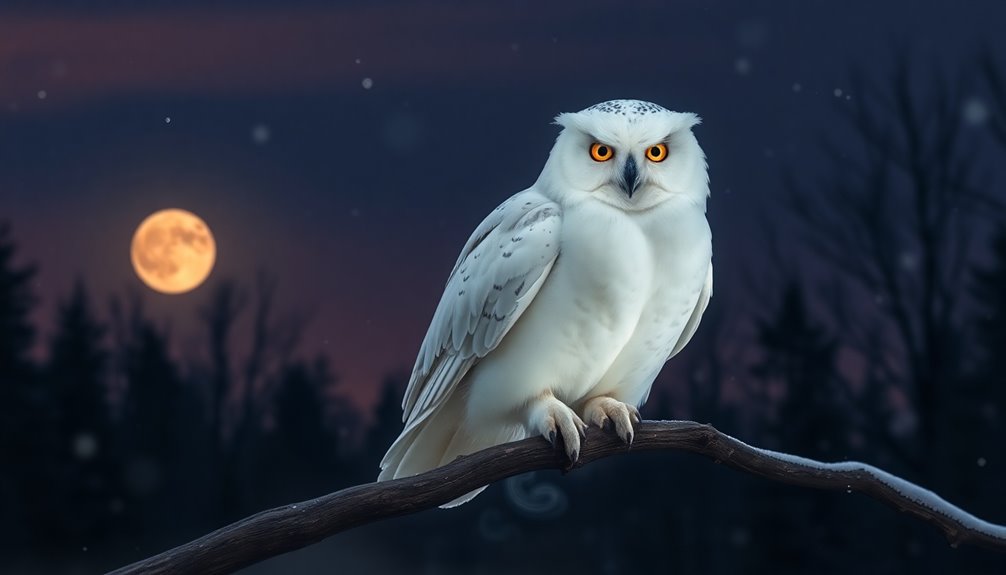
Recognizing the spiritual significance of white owls can deepen your understanding of personal changes and intuitive guidance. When a white owl appears in your life, it often symbolizes a powerful message from the universe.
These majestic creatures embody the spiritual meaning of owls, representing inner wisdom and clarity during times of change. Their pristine feathers reflect purity and spiritual renewal, guiding you from darkness into light.
As you commence on your journey of spiritual growth, the presence of a white owl can signal the start of significant changes. It encourages you to pay close attention to your surroundings and trust your intuition.
This connection to spirit guides offers profound wisdom, enhancing your psychic abilities and nurturing your spiritual awakening.
In many cultures, white owls are seen as messengers, bringing good fortune and protection. They remind you that you're not alone in your struggles and that your inner wisdom can lead the way.
Embrace the teachings of the white owl, and let its energy inspire you to navigate life's changes with grace and strength. Trust in the guidance it provides; your spiritual journey is unfolding beautifully.
Cultural Interpretations of White Owls
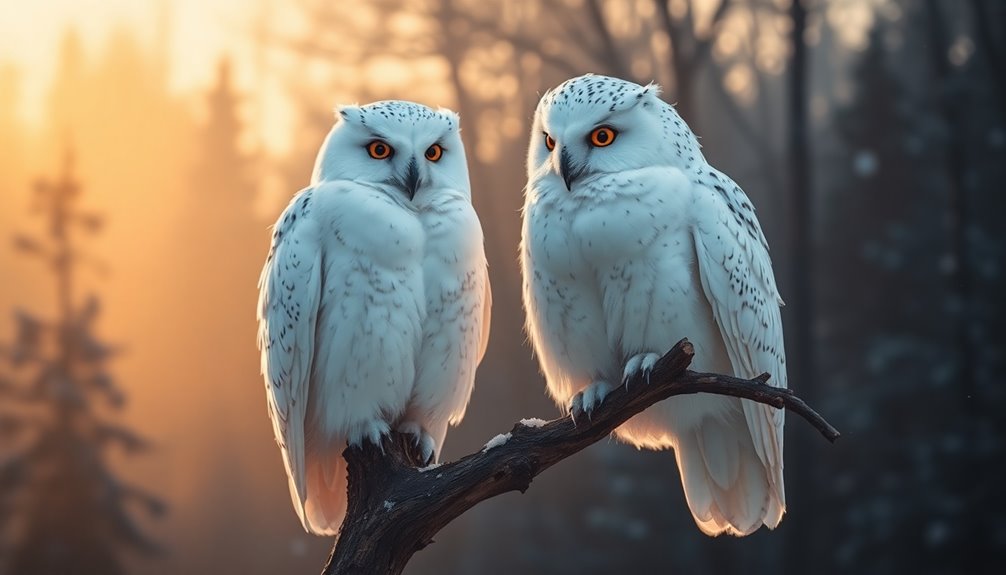
When you explore the cultural interpretations of white owls, you'll find fascinating mythological associations across the globe.
From Greek wisdom to Native American spirituality, each culture weaves its own unique narrative around these majestic birds.
Understanding these variations helps you appreciate how white owls symbolize different meanings in folklore and superstition.
Mythological Associations Worldwide
White owls hold rich mythological significance across various cultures, often embodying wisdom, protection, and change.
In Greek mythology, the White Owl is closely associated with Athena, the goddess of wisdom, symbolizing protection and knowledge during battles. This connection emphasizes the spiritual significance of the owl as a guardian and guide.
In Native American traditions, white owls are viewed as spiritual messengers, embodying the energy of ancestors and offering guidance during life changes. They're often seen as omens, providing insight into one's path.
Japanese folklore portrays white owls as symbols of good luck and protection, believed to attract positive energy while banishing negativity from one's life.
Conversely, in Mexican folklore, the "lechuza," or white owl, is depicted as a shape-shifting witch, showcasing both mystical and ominous qualities.
Celtic traditions associate white owls with the afterlife, considering them mysterious beings that guide individuals through the cycles of life and death.
Each of these interpretations highlights the profound symbolism of the White Owl, as it represents wisdom, protection, and spiritual insight across various mythologies worldwide.
Folklore and Superstitions
Throughout various cultures, the folklore and superstitions surrounding white owls illustrate their complex roles in human belief systems. The White Owl is often seen as a powerful symbol of wisdom and protection. In Greek mythology, you'll find white owls associated with Athena, representing knowledge and offering protection in battle.
In contrast, Native American cultures view these mystical birds as omens of death, acting as guides during your spiritual journey. Meanwhile, in Mexico, the white owl is believed to be a shape-shifting witch called "lechuza," embodying both mystical and protective qualities.
Japanese culture flips the script, viewing white owls as symbols of good luck and prosperity, believed to shield against negativity.
Here's a quick overview of these cultural interpretations:
| Culture | Belief/Interpretation |
|---|---|
| Greek | Symbol of wisdom and protection (Athena) |
| Native American | Omens of death, guides for spirits |
| Mexican | Shape-shifting witches ("lechuza"), protective |
| Japanese | Symbols of good luck, protectors against negativity |
These interpretations highlight the diverse spiritual meaning of the White Owl across different cultures.
Cultural Symbolism Variations
Exploring the cultural symbolism of white owls reveals a fascinating tapestry of interpretations that span the globe. In Native American cultures, you might find white owls revered as spiritual messengers, often linked to death and the connection between the physical and spiritual domains.
On the other hand, Greek mythology celebrates white owls as symbols of wisdom, closely associated with the goddess Athena, embodying protection and the pursuit of knowledge in life's battles.
In Japanese folklore, you'll see white owls regarded as bringers of good luck, serving as protectors against negativity and misfortune.
Meanwhile, Celtic traditions associate these mystical birds with the afterlife, representing the profound mysteries of death and rebirth.
In Mexican folklore, the white owl, or lechuza, takes on a dual role as a shape-shifting witch, symbolizing both supernatural power and cautionary themes about the unknown.
Each cultural interpretation enriches the symbolic landscape of white owls, highlighting their roles as harbingers of wisdom, protection, and the intricate connections between life, death, and the spiritual sphere.
Transformative Power of the White Owl
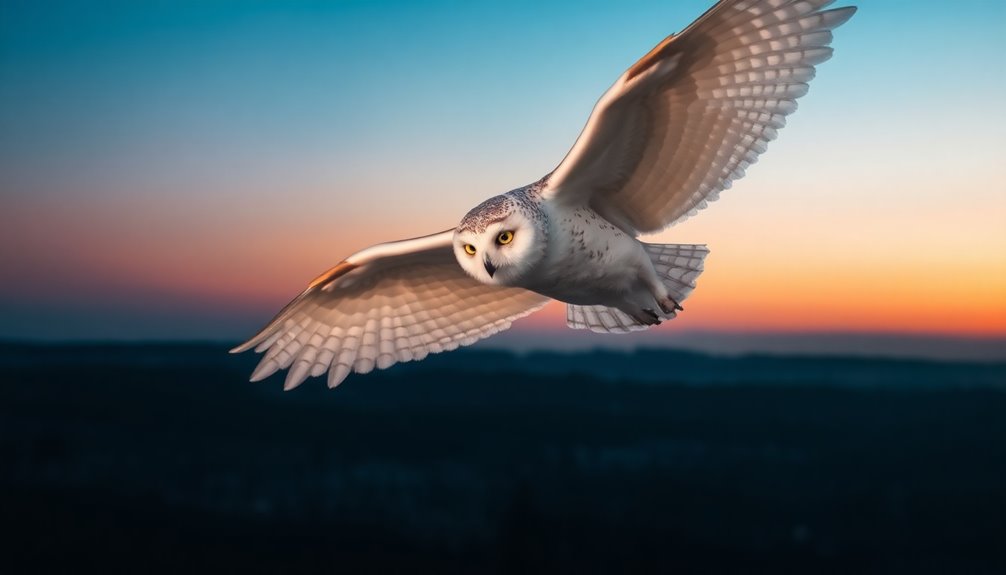
When you encounter a white owl, it's a powerful reminder of the spiritual transformations awaiting you.
This majestic creature guides you through change, encouraging you to embrace new beginnings with an open heart.
Trust in its presence, as it enhances your intuition and supports your journey toward personal growth.
Spiritual Transformation Insights
As you encounter the white owl, you may find yourself on the brink of profound spiritual transformation. This powerful symbol often appears during significant life changes, guiding you toward spiritual awakening and personal growth. The white owl serves as a reminder of the wisdom held within you, urging you to trust your intuition as you navigate through times of uncertainty.
Sighting a white owl can signal a spiritual message from the universe, indicating it's time for introspection. Embracing this moment allows you to acknowledge the cyclical nature of existence, where life and death intertwine. The symbolism of the white owl encourages you to accept both endings and new beginnings with an open heart and mind.
During periods of change, the white owl offers protection, reminding you that transformation is an essential aspect of your journey. By paying attention to your surroundings and the messages you receive, you can harness the transformative power of the white owl.
This mystical creature invites you to embrace your spiritual transformation, ultimately leading to greater awareness and understanding of your life's purpose.
Guidance During Change
The white owl stands as a powerful guide during times of alteration, offering clarity and direction when you need it most. As a spiritual messenger, the appearance of a white owl often heralds significant transformations in your life. These majestic creatures symbolize personal growth, urging you to embrace change rather than resist it.
When facing internal struggles, the sighting of a white owl invites deep introspection, prompting you to confront your fears and seek clarity. Their unique adaptability—represented by their ability to rotate their heads nearly 360 degrees—encourages you to trust the metamorphosis process, even when challenges arise.
In many cultures, white owls are seen as harbingers of good luck, reinforcing their role as guiding forces during pivotal moments. They remind you that change can lead to renewal and new beginnings, fostering resilience and strength.
As you navigate life's alterations, let the wisdom of the white owl illuminate your path, helping you find balance and direction. Embrace the guidance during change, and allow this mystical emblem to support your journey toward self-discovery and growth.
Embracing New Beginnings
Embracing new beginnings often involves letting go of the past and welcoming the possibilities that lie ahead. The White Owl serves as a powerful symbol of transformation, urging you to embrace significant life changes with an open heart.
When this majestic creature appears in your life, it's a sign that personal growth is on the horizon. The White Owl enhances your intuition, guiding you through uncertain times and helping you navigate your unique journey.
Its pristine white feathers represent spiritual purity and renewal, reminding you that each transformation can lead to a rebirth of the spirit and deeper self-awareness.
As you encounter this symbol, consider it a gentle nudge to engage in introspection. This reflective process allows you to release old patterns and truly welcome new opportunities.
The White Owl's presence offers protection, encouraging you to trust in your inner wisdom as you step into uncharted territory. Embracing curiosity can significantly enhance your problem-solving abilities, allowing you to approach new beginnings with an open and innovative mindset.
White Owl in Myths and Folklore
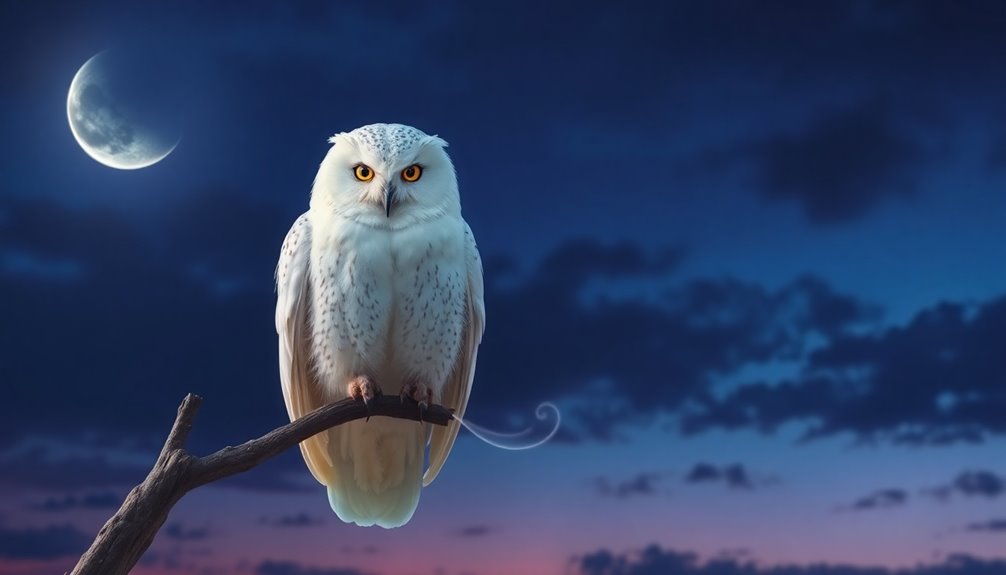
Throughout various cultures, white owls have captured the imagination of people, embodying a rich tapestry of meanings in myths and folklore. You'll find that these majestic creatures symbolize wisdom and protection across different traditions, each adding layers to their significance.
- In Greek mythology, white owls are sacred to Athena, the goddess of wisdom, representing strategic insight in battle.
- Native American cultures view white owls as spiritual messengers, often seen as omens of change that connect you to ancestors and the afterlife.
- In Mexican folklore, white owls, or lechuza, are shape-shifting witches illustrating their dual nature as protectors and cautionary figures.
- Japanese culture regards white owls as symbols of good fortune, believed to ward off negative energies while safeguarding ancestral ties.
Celtic traditions link white owls to the mystery of the afterlife, serving as guides through life's transformations.
Whether seen as protectors or symbols of wisdom, these enchanting birds invite you to explore the deeper meanings woven into the fabric of human belief.
Messages From White Owls
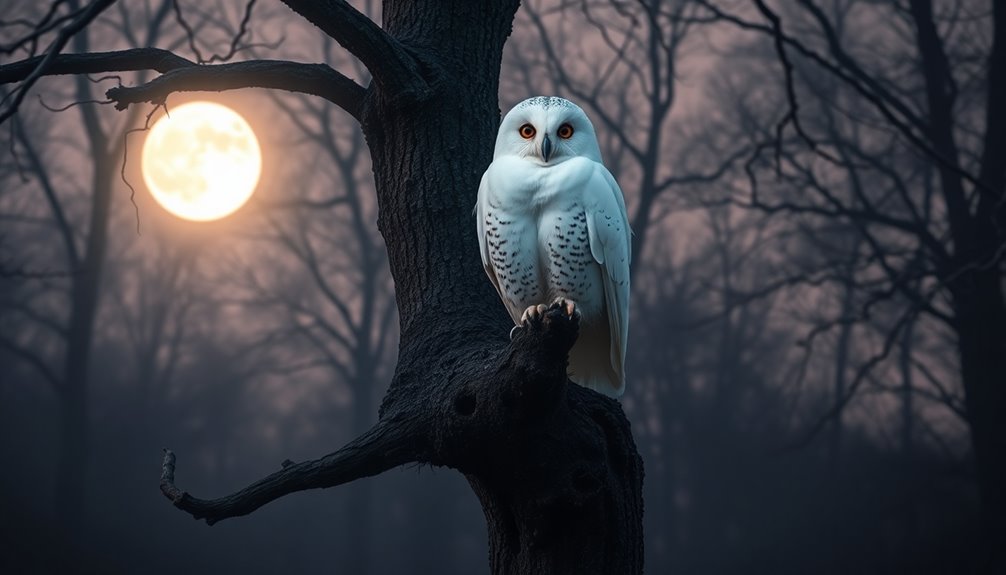
White owls are more than just symbols in myths; they act as spiritual messengers, delivering meaningful insights during pivotal moments in your life. When you encounter white owls, it's often a signal from the universe urging you to engage in introspection. These moments prompt you to examine your life circumstances closely and recognize hidden truths that may be influencing your path.
The presence of a white owl can herald imminent transformation, encouraging you to embrace new beginnings and foster personal growth. You might find that their appearances coincide with significant changes, serving as guidance and protection during this period. Trusting your intuition becomes essential, as these wise creatures help you navigate through uncertainty.
Repeated sightings of white owls in your daily life or dreams indicate important spiritual messages requiring your attention. They invite you to tap into your inner wisdom and reflect on your journey. By paying heed to their presence, you can uncover deeper insights that lead to profound transformation and align you with your true purpose.
Embrace these mystical encounters, as they guide you toward a more enlightened path.
White Owls in Dreams
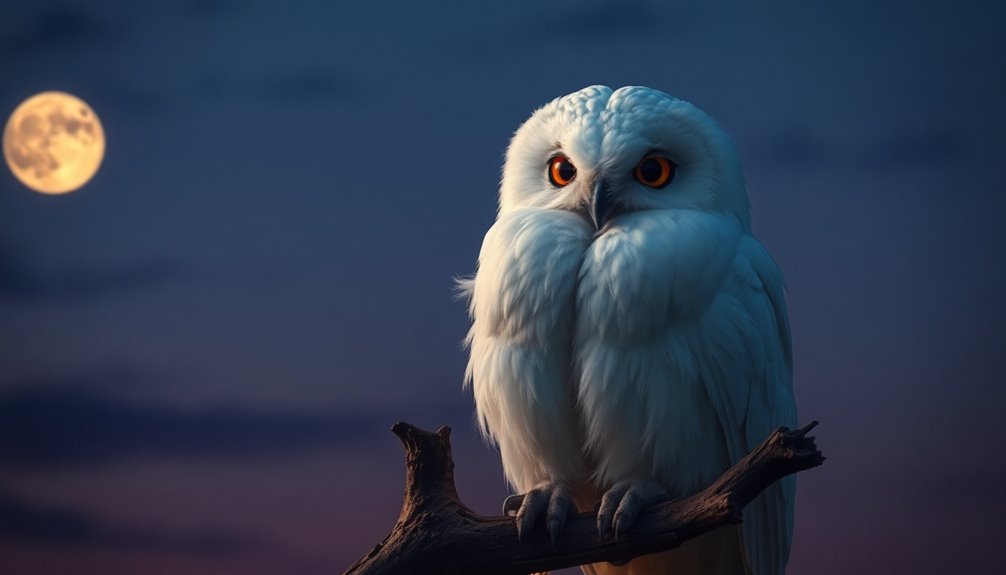
When you dream of a white owl, it often signals a quest for knowledge and a deeper understanding of your current life situation.
These dreams can indicate that you're seeking clarity amidst confusion, urging you to explore your emotional state and intuition. White owls serve as powerful symbols of spiritual guidance, revealing important messages from your subconscious.
Consider these deeper meanings when interpreting your white owl dreams:
- Wisdom and Intuition: The presence of a white owl suggests a call to trust your instincts and inner wisdom.
- Transformation: Flying with or being watched by a white owl can signify personal growth and transformation in your life.
- Messages from the Spiritual Dimension: Recurring dreams may indicate that you need to pay closer attention to spiritual messages related to your life's path.
- Protection: A white owl in your dreams can act as a guardian, providing comfort during times of change.
White Owl as a Spirit Animal
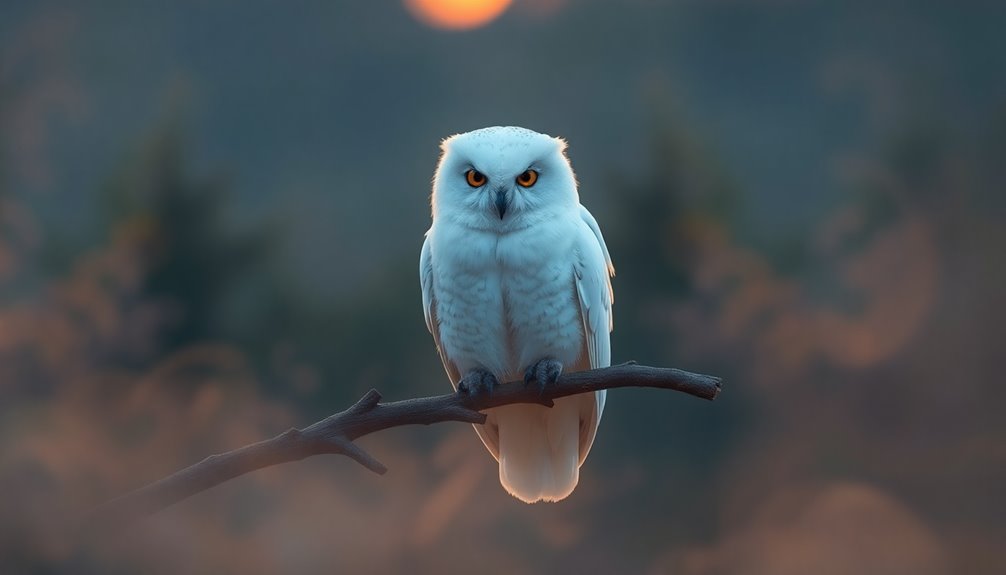
As you explore the significance of the white owl as a spirit animal, you'll discover it embodies profound wisdom and intuition, guiding you through life's complexities.
This powerful spirit animal encourages you to look beyond surface illusions and trust your inner wisdom. When the white owl appears in your life, it often signifies a significant change or shift, urging you to remain open to new opportunities and experiences.
Resonating with the white owl can lead to personal transformation, as it prompts you to engage in deep introspection and reflection.
Embracing this spirit animal can enhance your connection to spiritual dimensions and spark heightened psychic abilities, making it easier to navigate personal challenges.
In times of uncertainty, the white owl serves as a protector, helping you find clarity amid confusion.
By tapping into the guidance it offers, you can harness your intuition to make informed decisions and align with your true path.
Ultimately, the white owl as a spirit animal empowers you to embrace your journey with confidence, ensuring you remain grounded while exploring the depths of your soul.
Symbolism in Art and Literature
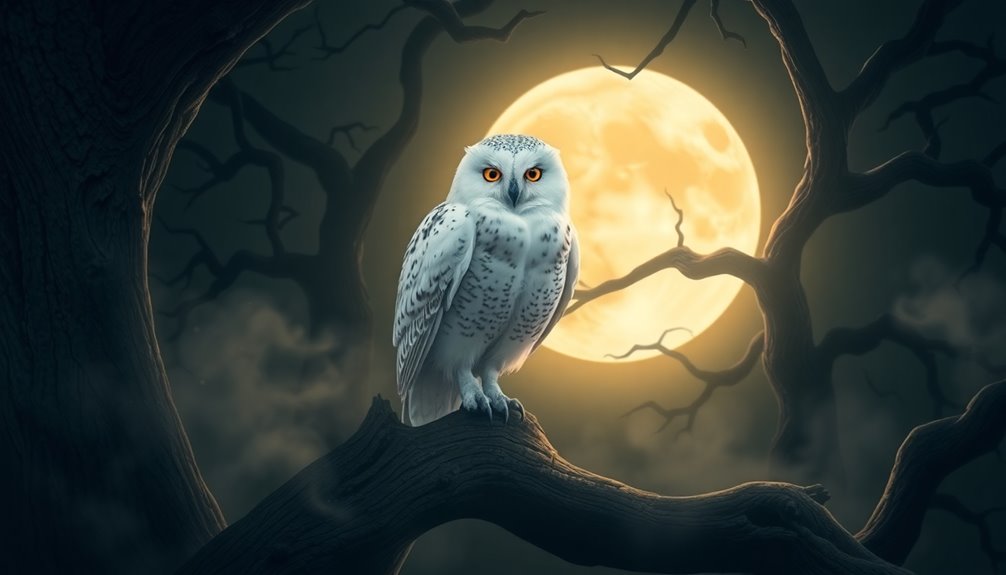
Owls, particularly the white variety, have captivated artists and writers for centuries, embodying wisdom and mystery. In various forms of art and literature, white owls symbolize not just beauty, but also serve as powerful representations of spiritual insight and protection. They often guide protagonists on transformative journeys, enriching narratives with their deep symbolism.
Here are some key themes regarding white owls in art and literature:
- Wisdom: Associated with the goddess Athena in Ancient Greek mythology, white owls represent knowledge and insight.
- Spiritual Significance: In Native American folklore, they act as messengers from the spirit world, reinforcing their connection to the mystical.
- Transformation: White owls symbolize personal growth and change, reflecting characters' journeys toward self-discovery.
- Protection: They often appear as guardians, offering safety and guidance during challenging times.
Through their striking plumage and piercing eyes, white owls evoke an ethereal beauty that enhances their role as symbols of wisdom.
Whether in mythology, literature, or art, their presence invites you to explore deeper meanings of your own spiritual journey.
Superstitions Surrounding White Owls

The haunting call of a white owl can send shivers down your spine, stirring a mix of fascination and fear. Superstitions surrounding white owls vary widely, revealing their dual nature as both omens of good luck and harbingers of caution. In many cultures, you might hear that these mystical creatures bring spiritual guidance and signify impending fortune. Their presence often suggests positive transformation, inviting you to embrace change.
However, tread carefully. Some Native American traditions associate white owls with death, implying that their appearance may foreshadow significant loss or shifts in life. In Mexican folklore, white owls are linked to shape-shifting witches, warning against malevolent forces and urging you to exercise caution.
The ancient Greeks viewed white owls as symbols of knowledge and protection, tied to Athena, the goddess of wisdom. This connection reinforces their protective qualities in some contexts. Additionally, the bond between a father and daughter can also be seen as a source of guidance and support, paralleling the protective nature attributed to white owls.
Yet, the superstitions also caution against venturing out at night, as the eerie calls of white owls might signal danger or misfortune. Balancing these beliefs may help you navigate the intriguing, complex world of white owl symbolism.
Frequently Asked Questions
What Does a White Owl Mean Spiritually?
When you encounter a white owl, it signals change and transformation in your life. This spiritual messenger encourages you to trust your intuition and embrace self-reflection, guiding you toward renewal and deeper spiritual awareness.
What Does the Wisdom Owl Symbolize?
The wisdom owl symbolizes knowledge, insight, and intuition. When you connect with this emblem, it encourages you to trust your instincts, seek clarity, and embrace personal growth, guiding you through life's complexities and transformations.
What Does a White Owl Symbolize in the Bible?
In the Bible, while white owls aren't specifically mentioned, they symbolize spiritual vigilance and the need for discernment. They prompt you to seek wisdom and guidance amidst desolation, reflecting your journey through darkness and uncertainty.
What Does an Owl Symbolize Spiritually?
When you think of an owl, imagine the wisest sage, whispering secrets of the universe. Spiritually, owls symbolize intuition, transformation, and guidance, urging you to embrace change and seek deeper understanding during life's pivotal moments.
Conclusion
In the tapestry of life, the white owl weaves threads of wisdom and protection, guiding you through the shadows. Whether it whispers ancient secrets in your dreams or stands sentinel in folklore, its presence beckons you to embrace transformation. As you journey onward, remember the white owl's watchful gaze—an emblem of clarity and insight. Let its spirit inspire you, igniting a spark of wonder as you navigate the mysteries that lie ahead.
Under Kirsti’s gentle guidance, each insight and interpretation is thoughtfully crafted to uplift, educate, and encourage personal transformation. Whether you’re a dedicated seeker on a lifelong spiritual quest or taking your very first step into the mystical, we offer a wealth of knowledge and supportive community to illuminate your unique journey.
Symbolism
What Does Green Eyes Symbolize? The Vibrant Insight Behind the Emerald Gaze!
Intrigued by the allure of green eyes? Discover the captivating symbols and cultural meanings behind this rare eye color that will leave you wanting more.
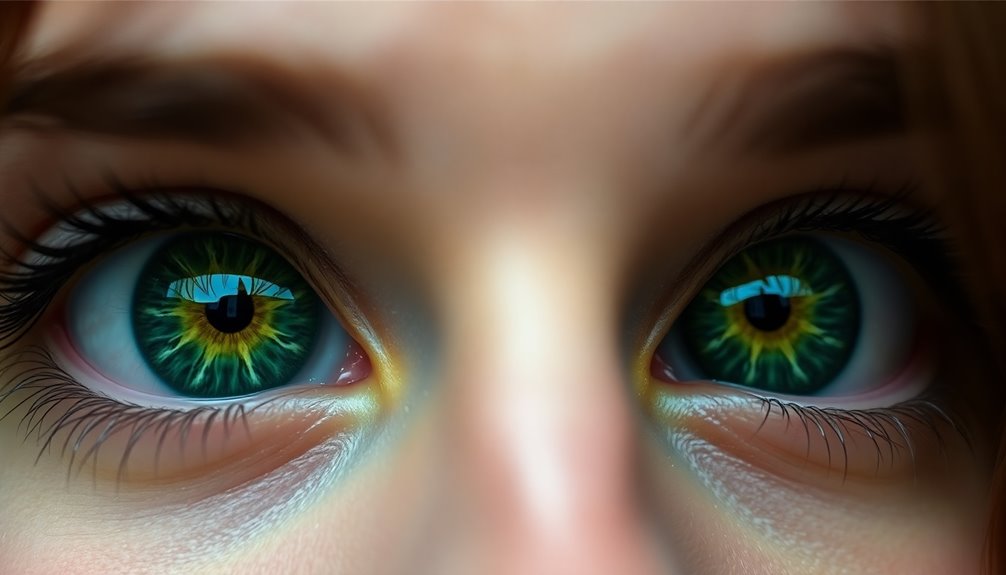
Green eyes, a enchanting rarity found in just 2% of people, symbolize beauty, complexity, and emotional depth across various cultures. Their striking hue ties back to ancient Egypt, where they were linked to healing, while in Greek mythology, they reflected jealousy. In literature and art, characters with green eyes often embody intrigue and inner conflict, drawing you into their narratives. Today, green eyes remain desirable and alluring, celebrating a blend of fortune and mystique. If you're curious about more fascinating aspects of this unique eye color and its cultural significance, there's so much more to uncover!
Key Takeaways
- Green eyes symbolize beauty and emotional depth, revered for their rarity and unique genetic origins.
- In various cultures, they represent complexity, often linked to themes of jealousy and mystique.
- Historical figures like Cleopatra and Elizabeth Taylor exemplify the allure associated with green eyes.
- Literature frequently uses green eyes to highlight characters' inner struggles and emotional duality.
- Modern society celebrates green eyes as a symbol of fortune, beauty, and artistic inspiration.
The Allure of Green Eyes
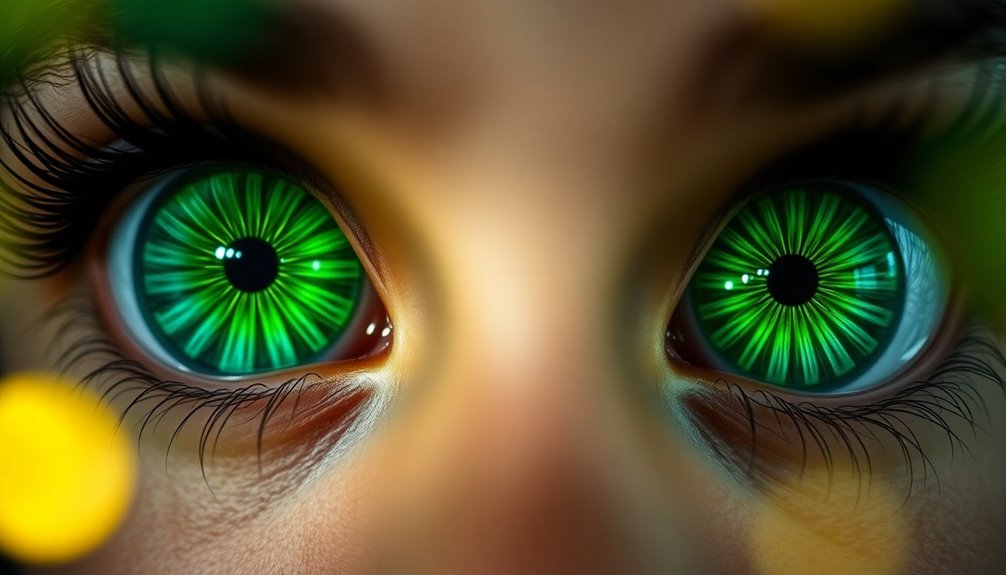
When you encounter someone with green eyes, it's hard not to be fascinated by their unique charm. The allure of green eyes lies in their rarity, as only about 2% of the global population boasts this striking eye color.
Often referred to as "emerald gaze," these enchanting hues can shift with the light, revealing an emotional depth that draws you in. Historically, individuals with green eyes have been associated with mystique and enchantment, often portrayed in folklore as having special powers.
This cultural significance enhances the symbolism of green, representing not just beauty but also hidden meanings like passion, jealousy, and renewal. In literature and popular culture, green eyes are celebrated for their allure, seen in iconic characters like Scarlett O'Hara and Harry Potter, who embody strength and complexity.
The unique eye color of green is more commonly found in people of Celtic and Northern European descent, adding to its mystique. The combination of low melanin and lipochrome pigments creates mesmerizing optical effects, making the emerald gaze an enchanting sight.
Rarity and Distribution
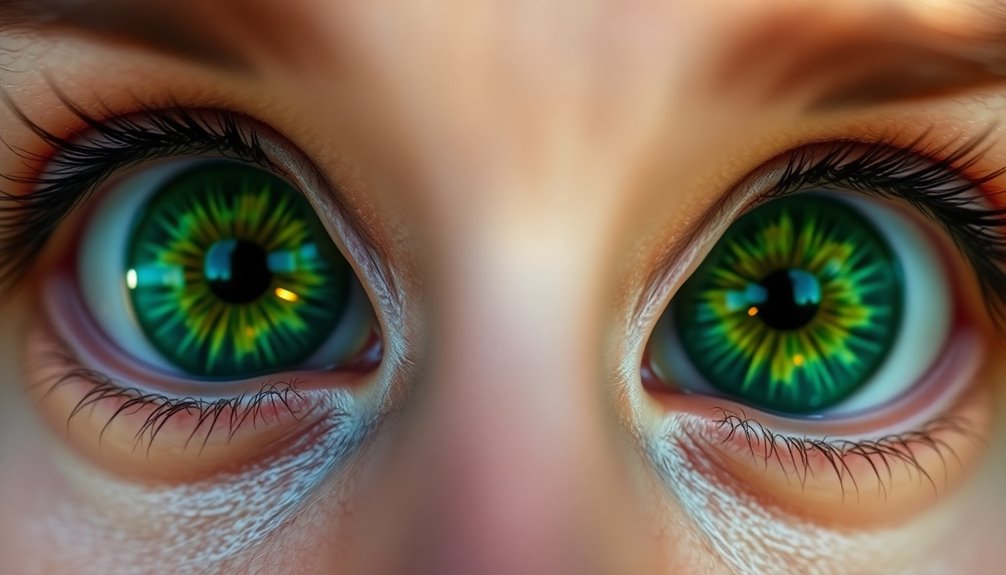
The rarity of green eyes captivates many, as only about 2% of the global population possesses this striking hue. Unlike the more common brown and blue eye colors, green eyes are quite exceptional. Their unique color arises from specific genetic mutations associated with the OCA2 and HERC2 genes, which play a vital role in melanin production in the iris.
You'll find the highest concentrations of green eyes in Celtic and Northern European regions, particularly in countries like Ireland and Scotland. This geographical distribution highlights how green eyes often correlate with specific heritage and ancestry.
In fact, if you have green eyes, you might be part of a unique genetic lineage that connects you to these areas.
The rarity of green eyes not only makes them visually stunning but also adds an intriguing layer of mystique. When you encounter someone with green eyes, you're likely witnessing a rare combination of genetics and heritage that isn't seen every day.
This distinctive eye color, often accompanied by lighter skin tones, stands out in a world dominated by more common shades.
Genetic Origins of Eye Color
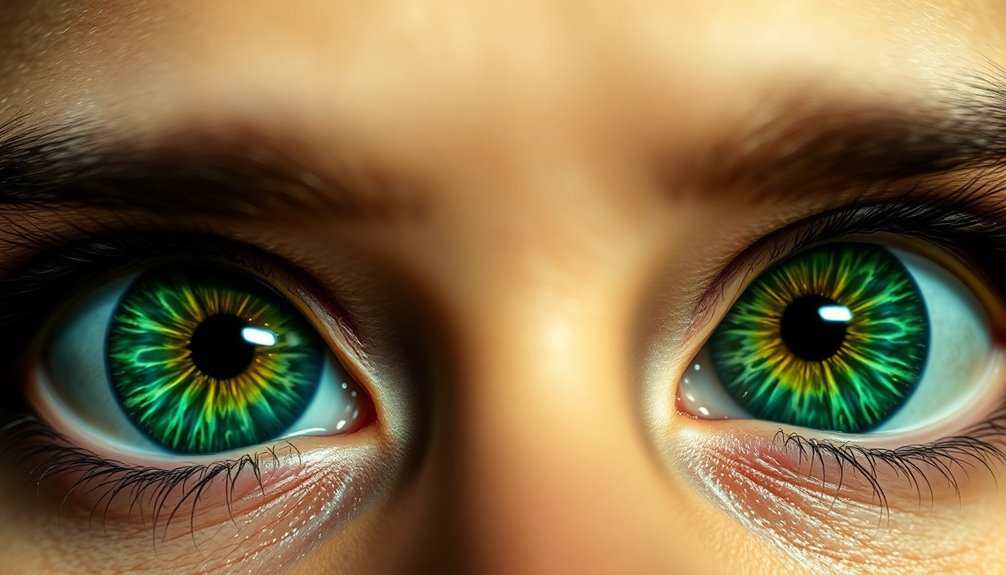
When you look into the genetics of eye color, you'll find that it's shaped by the interplay of several genes, especially OCA2 and HERC2.
Green eyes emerge from a unique combination of melanin and lipochrome, making them a rare genetic trait.
This rarity stems from the specific alleles required from both parents, leading to their distinctive hue being less common in the global population.
Eye Color Genetics
Understanding the genetic origins of eye color reveals a fascinating interplay of various genes and pigments. Eye color genetics primarily hinges on the OCA2 and HERC2 genes, which regulate the levels of melanin and lipochrome in your iris.
For green eyes, a moderate amount of eumelanin combines with pheomelanin, producing that unique and enchanting hue. Only about 2% of the global population has green eyes, making them a rare eye color. This rarity is largely tied to the geographic distribution of individuals with Celtic ancestry, especially in regions like Ireland and Scotland.
Genetic variations influence the phenotypic expression of eye color, resulting in the diverse shades we see today. Environmental factors also play a role, as they can modify how these genes manifest.
The complex interaction between genes and pigments means that even within the same family, eye colors can vary considerably. So, if you have green eyes, you carry a piece of this intricate genetic puzzle, reflecting not just your heritage but also the broader tapestry of human diversity.
Rare Genetic Combinations
Rare genetic combinations play an essential role in determining eye color, particularly in the case of green eyes. These enchanting emerald hues arise primarily from the interplay of the OCA2 and HERC2 genes, which influence low melanin levels in the iris. This combination creates a unique pigmentation, leading to the striking appearance of green eyes in humans.
Green eyes are among the rarest eye colors, occurring in only about 2% of the global population. Their prevalence is significantly higher in Northern Europe and Western Asia, especially among individuals of Celtic and Germanic descent. This geographic distribution highlights how certain genetic mutations contribute to the unique qualities of green eyes.
Environmental factors may also play a role in the expression of these genetic traits, adding another layer of complexity to eye color variation. Additionally, cases of heterochromia, where one eye is green and the other a different color, exemplify the diversity of genetic influences on eye color. Understanding these rare genetic combinations not only sheds light on the origins of green eyes but also enhances your appreciation for the beauty and complexity of human genetics. Furthermore, the concept of soulmates and destiny can be metaphorically linked to the rarity of green eyes, as both are unique and valuable connections in the tapestry of human experience.
Symbolism Across Cultures
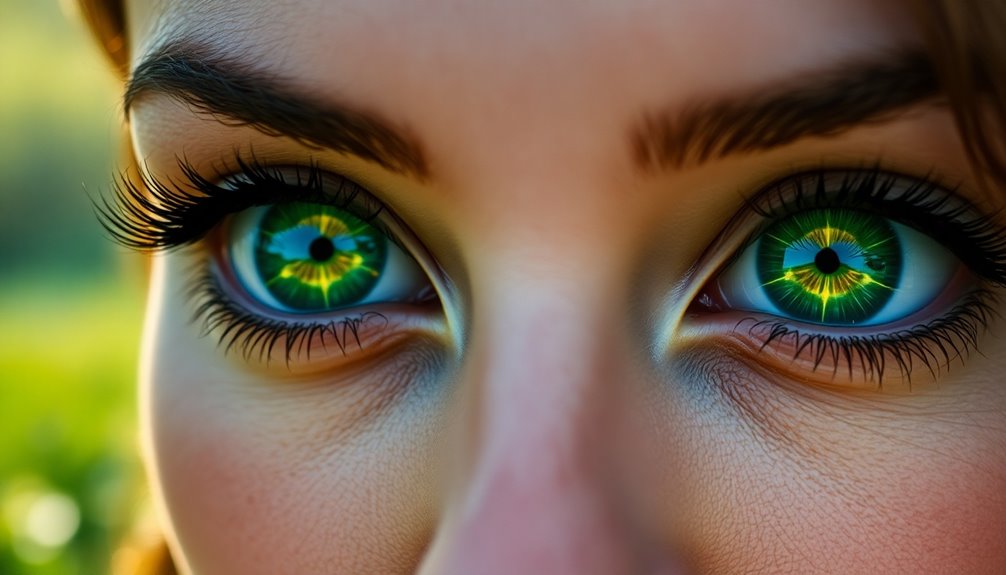
Green eyes carry rich symbolism across various cultures, often embodying a blend of beauty and complexity. In ancient Egypt, people linked green eyes to the god Horus, symbolizing healing and protection, thanks to their mystical powers.
Similarly, Greek mythology often portrayed the goddess Hera with green eyes, representing jealousy and showcasing the emotional complexity associated with this enthralling hue.
Celtic traditions embraced green-eyed leprechauns, associating them with luck and mischief, which highlighted the enchanting qualities of individuals with this eye color.
In Shakespearean literature, green eyes frequently emerged as symbols of jealousy and suspicion, further illustrating the duality of the beauty of green eyes intertwined with darker emotions.
Today, the allure of green eyes persists, often tied to themes of magic and mystery in modern art and literature. The association with supernatural abilities magnifies their appeal, making them a symbol of both fascination and intrigue.
Whether seen as embodiments of luck, jealousy, or ethereal charm, green eyes remain steeped in rich cultural narratives that celebrate their vibrant and multifaceted nature.
Historical Perspectives

When you explore historical perspectives on green eyes, you'll uncover a rich tapestry of cultural myths and iconic figures.
From ancient gods to legendary creatures, these associations have shaped how societies perceive green eyes over time.
You'll find that these perceptions have evolved, reflecting changing attitudes toward beauty, emotion, and mystique.
Cultural Myths and Legends
Throughout history, various cultures have imbued green eyes with rich symbolism, weaving them into the fabric of myths and legends. In ancient Egypt, green eyes were linked to the god Horus, symbolizing healing and protection, highlighting their cultural significance.
Greek mythology presents a contrasting image, where the goddess Hera, with her green eyes, often embodies jealousy and envy, showcasing the dual nature of this eye color.
In Irish and Scottish culture, green-eyed individuals are compared to leprechauns, who symbolize good fortune and mischief, further emphasizing the enchanting qualities associated with green eyes.
Shakespearean literature reinforces this theme, using green eyes as symbols of jealousy and suspicion, shaping societal perceptions throughout the ages.
Today, people often connect green eyes with magic and the supernatural, adding layers of mystery to their allure.
Across various artistic expressions, this eye color remains a potent symbol, encapsulating both beauty and intrigue.
Whether associated with fortune, envy, or mysticism, green eyes continue to captivate our imagination, reminding us of their deep-rooted place in cultural mythology.
Historical Iconic Figures
Many historical figures with green eyes have left an indelible mark on culture, often embodying qualities that enhance their legendary status. Cleopatra, with her mesmerizing beauty and mystique, symbolizes how green eyes can amplify allure and power throughout history.
Similarly, Elizabeth Taylor's striking green eyes made her an iconic figure in Hollywood, reinforcing the cultural fascination with this unique eye color.
In Greek mythology, the goddess Hera, often depicted with green eyes, represents complex emotional themes like jealousy, embedding these traits deeply in art and literature.
David Bowie, celebrated for his unique green eyes, contributed to the narrative that links this eye color to creativity and artistry, establishing him as a lasting icon.
The allure of green eyes also extends to supernatural associations, as history often romanticizes characters who possess this rare trait.
These iconic figures showcase how green eyes can symbolize beauty, mystique, and emotional depth, leaving a lasting impression on culture.
Through their stories, you see that green eyes carry an extraordinary weight, blending creativity and history into a vivid tapestry of human experience.
Changing Societal Perceptions
Green eyes have undergone a fascinating evolution in societal perceptions across different historical contexts. From being symbols of mysticism and beauty to associations with jealousy and witchcraft, these vibrant hues reflect changing societal attitudes over time.
- Mysticism and Spirituality: In ancient Egypt, green eyes were linked to the god Horus, symbolizing healing and protection, showcasing their cultural significance in spiritual contexts.
- Witchcraft and Suspicion: During medieval Europe, green-eyed individuals faced suspicion and were often associated with witchcraft, reflecting societal fears of those who deviated from the norm.
- Beauty and Jealousy: In Shakespearean works, green eyes conveyed emotional states like jealousy, highlighting the complexity of human relationships and the darker connotations tied to this eye color.
In modern culture, green eyes are celebrated as symbols of beauty and mystery, often depicted in celebrities and fictional characters.
This transformation illustrates how perceptions of green eyes have shifted from fear and suspicion to admiration and allure, emphasizing their evolving cultural significance.
Today, they embody a blend of mysticism and beauty, making their emerald gaze enchanting across different societal landscapes.
Green Eyes in Literature
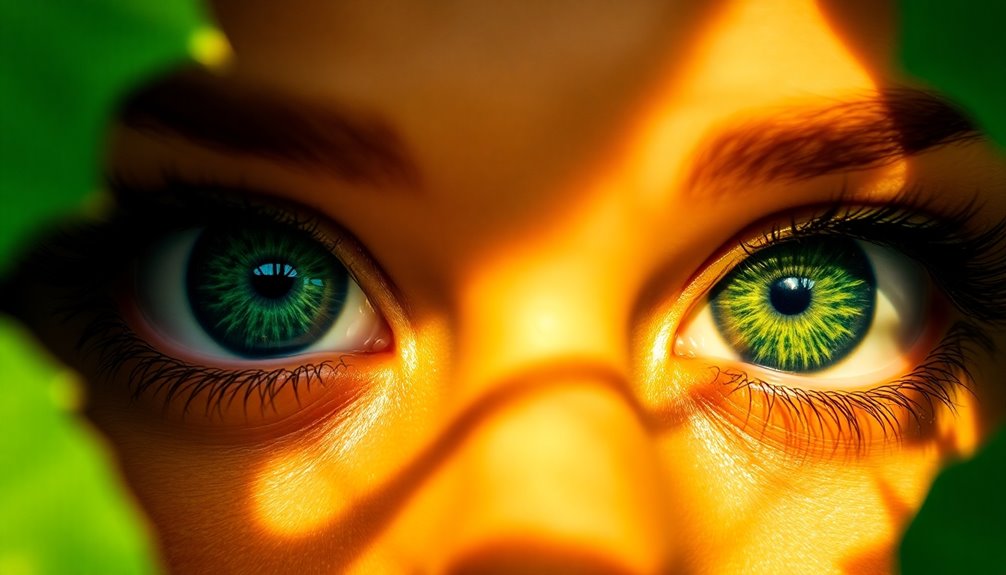
Have you ever noticed how characters with green eyes often seem to hold a certain allure or mystery? In literature, green-eyed people frequently embody this enigmatic quality, drawing readers in with their enchanting presence.
Take Scarlett O'Hara from "Gone With the Wind," for instance. Her green eyes reflect her complexity, charm, and emotional depth, showcasing her individuality in a tumultuous world.
Similarly, in J.K. Rowling's "Harry Potter," Harry's striking green eyes symbolize his unique heritage and exceptional abilities. They set him apart from others and enhance the mystery surrounding his character.
Moreover, green eyes in literature often carry connotations of jealousy and envy. Shakespearean works illustrate this theme, where green-eyed individuals embody these potent emotions, adding layers to their personalities.
Ultimately, the symbolism of green eyes extends beyond mere physical description. These characters represent a blend of mystery and emotional depth, allowing readers to connect with their inner struggles and unique perspectives on life.
Influence of Environment
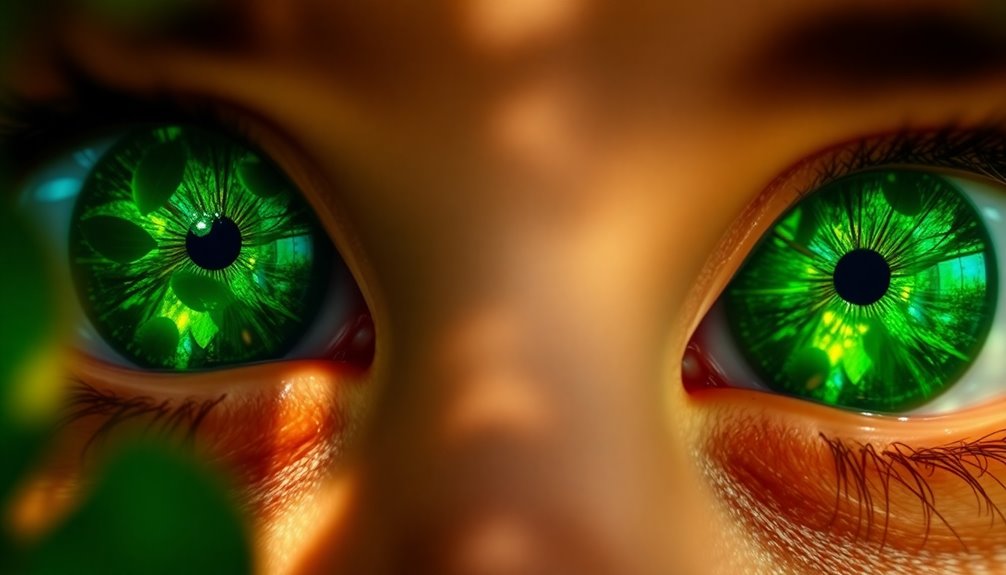
Characters with green eyes not only draw intrigue through their literary presence but also reflect the profound influence of their environments. The way you perceive green eyes can shift dramatically based on various environmental factors, making them appear more vibrant or muted.
Here are three key influences:
- Lighting Conditions: Sunlight can enhance the brightness of your green eyes, while dim lighting may soften their hue. This optical dance is partly due to Rayleigh scattering, where shorter wavelengths scatter more, affecting how you see that emerald gaze.
- Connection with Nature: Seasonal changes and natural surroundings can evoke a deeper emotional connection for you. Lush greenery amplifies the green in your eyes, linking your perception of beauty with the world around you.
- Eye Health and Lifestyle: A diet rich in carotenoids and antioxidants not only supports eye health but also enhances the clarity and vibrancy of your green eyes. By taking care of your environment and lifestyle, you can reflect the beauty inherent in your gaze.
Ultimately, the interplay between your green eyes and environment creates a unique and vibrant identity.
Modern Cultural Significance
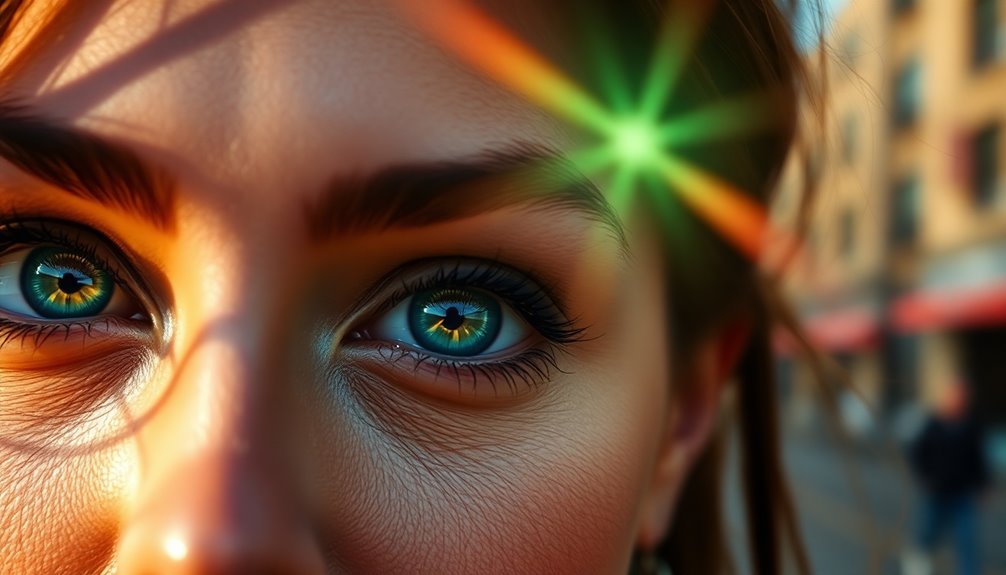
In today's society, green eyes captivate attention and symbolize beauty and allure, often portraying characters that embody these traits in literature and film. Iconic characters like Scarlett O'Hara from "Gone With the Wind" and Harry Potter showcase the enchanting qualities associated with green eyes. This rarity, found in only about 2% of the global population, enhances their desirability and mystique in modern culture.
Celebrities such as Elizabeth Taylor and David Bowie have further cemented green eyes as a representation of exceptional beauty, inspiring admiration and fascination. In music, songs like Coldplay's "Green Eyes" highlight the emotional depth linked to individuals with this striking feature, adding another layer to their allure.
Social media platforms have become hubs for celebrating unique traits, where individuals with green eyes connect, share experiences, and create communities around their differences. Trending hashtags amplify this celebration, allowing people to embrace their green-eyed identity.
Ultimately, green eyes remain a powerful symbol of beauty and allure, influencing fashion and cultural trends while continuing to capture the hearts and imaginations of many.
Frequently Asked Questions
What Does the Green Eye Symbolize?
When you think about green eyes, you might see them as a symbol of rarity and uniqueness. They can evoke feelings of mystique and allure, drawing people in.
You may also notice that green eyes often connect to deeper emotions, like envy or jealousy. Additionally, they can represent growth and renewal, reflecting your adaptability.
With their vibrant hue, green eyes suggest heightened insight and intuition, helping you navigate life's complexities with a unique perspective.
What Does It Mean When You Dream About Bright Green Eyes?
When you dream about bright green eyes, it can reflect your feelings of jealousy or insecurity.
For instance, if you recently envied a friend's promotion, those green eyes might symbolize your struggle with self-worth.
This dream urges you to embrace personal growth and explore hidden emotions. It invites you to communicate openly, fostering clarity in your relationships.
Ultimately, it signals a readiness for healing and transformation, encouraging you to seek deeper self-understanding.
What Does the Metaphor Green Eyes Mean?
When you encounter the metaphor "green eyes," it usually evokes feelings tied to jealousy or envy. It can reflect the complexities of your relationships and aspirations.
However, it also suggests a sense of mystique and uniqueness in individuals, hinting at deeper insights or emotional understanding.
Sometimes, it symbolizes new beginnings and personal growth, encouraging you to embrace transformation and healing in your journey, as you navigate through life's challenges and opportunities.
How Do You Describe Emerald Green Eyes?
When you describe emerald green eyes, you can't help but highlight their striking vibrancy.
These enchanting eyes often shimmer with a depth that seems to change with the light, making them even more alluring.
You might notice how they evoke emotions and draw people in, hinting at a rich, unique heritage.
The rarity of this eye color adds to its mystique, creating an impression of intuition and sensitivity that's hard to ignore.
Conclusion
To sum up, green eyes carry a unique charm, symbolizing mystery and liveliness across various cultures. Did you know that only about 2% of the world's population has green eyes? This rarity adds to their entrancing reputation, making those with emerald gazes stand out even more. Whether in literature or everyday life, green eyes spark curiosity and admiration. So, the next time you encounter someone with this alluring eye color, remember the vibrant stories and meanings behind their gaze!
Under Kirsti’s gentle guidance, each insight and interpretation is thoughtfully crafted to uplift, educate, and encourage personal transformation. Whether you’re a dedicated seeker on a lifelong spiritual quest or taking your very first step into the mystical, we offer a wealth of knowledge and supportive community to illuminate your unique journey.
Symbolism
What Does Grey Eyes Mean? Unveiling the Subtle Symbolism of Ashen Gaze!
Curious about the deeper meanings behind grey eyes? Discover the subtle symbolism that makes this captivating gaze so intriguing and unique.
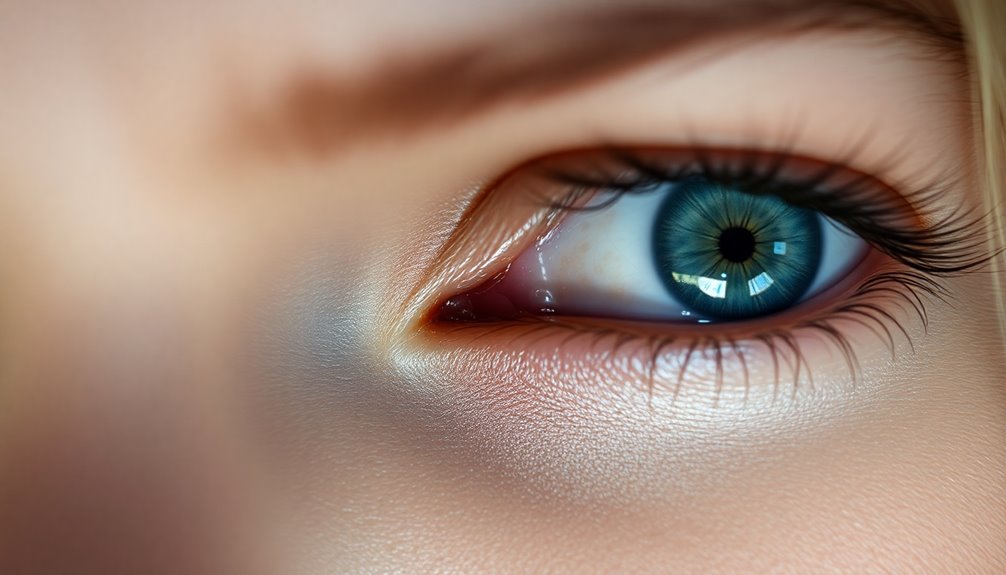
Grey eyes, with their rare and enchanting hues, often evoke a sense of mystery and emotional depth. This unique eye color, found in only 1% to 3% of people, symbolizes individuality and introspection. Their shades can reflect surroundings, revealing hidden complexities, which intrigues those around you. Culturally, grey eyes are linked to creativity and wisdom, often associated with captivating characters in literature and folklore. Studies suggest that you might be viewed as more enigmatic with grey eyes, sparking curiosity and admiration. If you want to uncover more fascinating insights about this striking color, keep exploring!
Key Takeaways
- Grey eyes symbolize mystery and emotional complexity, often evoking feelings of intrigue and depth in individuals.
- The rarity of grey eyes, found in only 1% to 3% of the population, enhances their uniqueness and individuality.
- Culturally, grey eyes represent creativity, wisdom, and introspection, with historical associations to supernatural beings and ethereal powers.
- Individuals with grey eyes are often perceived as enigmatic, influencing social dynamics and first impressions positively.
- In art and literature, grey eyes are depicted to evoke emotions and symbolize the connection to the otherworldly or complex narratives.
Characteristics of Grey Eyes

When you look into the enchanting depths of grey eyes, you might notice their remarkable range of shades, from light to dark grey, occasionally shimmering with hints of blue or green. These different shades create an allure that fascinates those around you.
Light grey eyes often appear brighter, reflecting the surrounding light in a way that can reveal subtle undertones, while dark grey eyes maintain a deep, rich pigmentation that conveys mystery.
The unique appearance of grey eyes stems from lower melanin levels, which leads to a distinctive light scattering effect. This phenomenon enhances their beauty, making them seem almost ethereal in certain lighting conditions.
You might find that environmental factors play a significant role in how grey eyes are perceived; depending on the surroundings, they can shift in hue, sometimes appearing bluer or greener.
This fascinating variability contributes to their charm and makes every pair of grey eyes uniquely individual.
With only about 1% to 3% of the global population boasting this eye color, those with grey eyes possess a rare and enchanting quality that sets them apart.
Rarity of Grey Eyes

Grey eyes are incredibly rare, found in only about 1% to 3% of the global population. Their rarity is fascinating, especially when you consider that they're more commonly seen in high-latitude regions like Russia and Eastern Europe.
In contrast, grey eyes are almost non-existent in equatorial areas such as Asia and Africa. This geographical distribution connects to the lower melanin levels found in people who live where sunlight is less intense.
The different shades of grey, like green-grey, smokey-blue, and hazel-grey, add to their unique beauty.
Because of their scarcity, grey eyes symbolize something special in various cultures. Many societies associate them with mystery, creativity, and freedom. This symbolism often portrays individuals with grey eyes as enigmatic figures, almost as if they possess a supernatural quality.
Genetic Factors Behind Grey Eyes
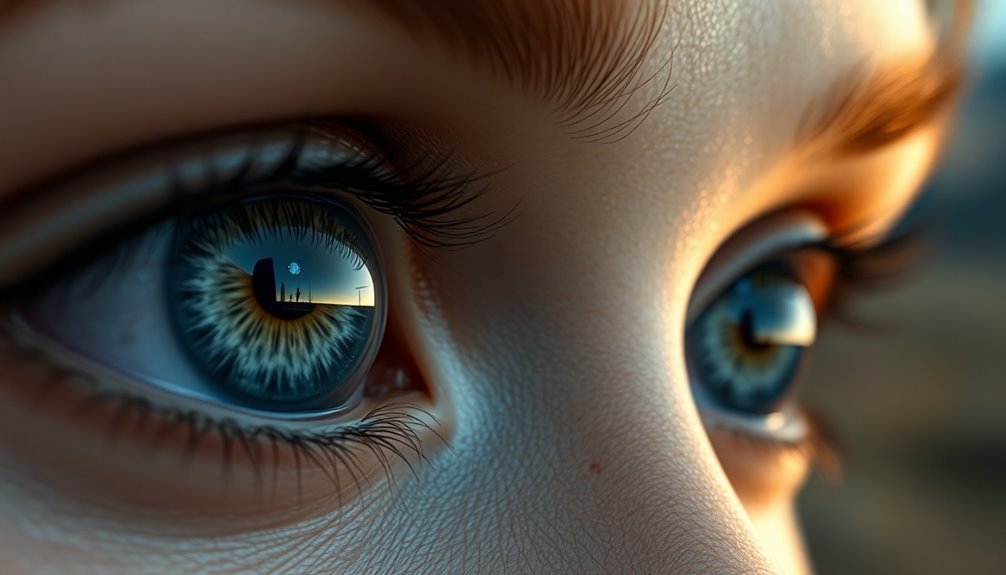
Understanding the genetic factors behind grey eyes reveals a complex interplay of multiple genes. The primary gene involved is OCA2, located on chromosome 15, which plays a significant role in iris pigmentation. This gene interacts with the HERC2 gene, which regulates OCA2 and influences melanin synthesis. The result? Low melanin levels that give grey eyes their unique appearance.
Here's a quick overview of the genetic factors influencing grey eyes:
| Gene | Role | Impact on Grey Eyes |
|---|---|---|
| OCA2 | Iris pigmentation | Determines eye color intensity |
| HERC2 | Regulates OCA2 | Influences melanin production |
| Melanin | Pigment in eyes | Low levels lead to grey appearance |
| Genetic Variability | Variations in genes | Contributes to rarity of grey eyes |
| Environmental Factors | Geographical and sunlight exposure | Affects prevalence and expression |
Approximately 1% to 3% of the global population has grey eyes, making them one of the rarest eye colors. Notably, grey eyes usually have slightly more melanin than blue eyes, contributing to light sensitivity.
Symbolism of Grey Eyes

Eyes can be windows to the soul, and grey eyes often evoke a sense of mystery and depth. This unique eye color symbolizes a balance between emotional complexity and introspection.
In literature and folklore, characters with grey eyes frequently embody wisdom or enigma, suggesting a connection to the supernatural or otherworldly. Because grey eyes are found in only 1% to 3% of the global population, their rarity enhances their symbolic value, representing uniqueness and individuality.
Cultural interpretations of grey eyes vary widely. In some societies, they symbolize creativity and freedom, while in others, they might be seen as a sign of danger, depending on the context.
The shifting hues of grey eyes in different lighting conditions further deepen their symbolism, showcasing adaptability and the multifaceted nature of human emotion and experience.
Personality Traits Associated With Grey Eyes

People often associate grey eyes with a unique blend of personality traits that set individuals apart from the crowd. Those with grey eyes are frequently regarded as wise and strategic thinkers, echoing ancient Greek beliefs that link this eye color to intelligence. You might find that people perceive you as more faithful, suggesting a strong inclination towards loyalty and commitment in your relationships.
Moreover, while not scientifically validated, some theories hint that grey-eyed individuals often display competitiveness and ambition. This drive can shape your professional and personal pursuits, pushing you to excel in various aspects of life.
The rarity of grey eyes, seen in only 1% to 3% of the global population, often fosters a sense of distinctiveness and creativity within you.
Additionally, the cultural interpretations of grey eyes can enhance perceptions of your personality. In some societies, people attribute mysterious or even supernatural qualities to those with grey eyes, which may add an engaging layer to how others view you.
Cultural References to Grey Eyes
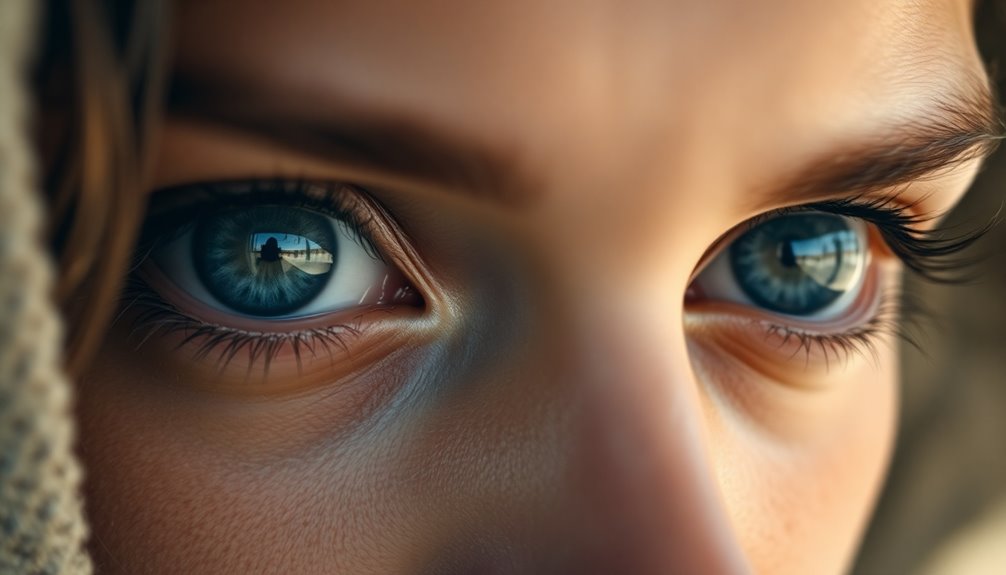
When you explore cultural references to grey eyes, you'll find that they often symbolize mystery and the unknown, hinting at deep secrets beneath the surface.
Many myths link grey eyes to supernatural beings, suggesting a connection to ethereal powers and wisdom.
This unique eye color not only stands out but also carries varied meanings across different societies, enhancing its allure.
Mythical Associations With Grey
Throughout history, grey eyes have captivated the imagination, often linked to supernatural beings like angels and wizards. These mythical associations highlight the unique allure of grey eyes, suggesting a depth of insight and emotional distance. In various cultures, individuals with this eye color are thought to possess wisdom and creativity, embodying both freedom and mystery.
Here's a table illustrating these mythical associations:
| Culture/Reference | Association with Grey Eyes |
|---|---|
| Ancient Greece | Wisdom and strategic thinking |
| Literature (Harry Potter) | Elemental powers and emotional distance |
| Folklore | Heightened sensitivity to sunlight and alcohol |
| Art and Expression | Symbols of creativity and uniqueness |
| Supernatural Beings | Links to angels and wizards |
As you explore these associations, you'll find that grey eyes serve as a canvas for various interpretations across cultures. They not only evoke a sense of wonder but also invite curiosity about the deeper meanings behind this rare eye color. Embracing these mythical associations enriches your understanding of the enchanting nature of grey eyes.
Cultural Symbolism of Mystery
Grey eyes have long been shrouded in cultural symbolism, often representing mystery and intrigue. This eye color is frequently linked to qualities like freedom, creativity, and emotional depth. In ancient Greek mythology, grey eyes were associated with wisdom, suggesting that those who possess them might've strategic thinking and insightful perspectives.
Literary and cinematic characters like Draco Malfoy and Luna Lovegood reinforce this mysterious aura; they often embody traits that hint at elemental powers or emotional distance. The portrayal of grey eyes in these narratives underlines their connection to the enigmatic.
Cultural perceptions of grey eyes vary widely. In some societies, they're admired for their uniqueness and beauty, while in others, they may evoke supernatural themes, suggesting a connection to angels or spirits.
The rarity of grey eyes—found in only 1% to 3% of people globally—intensifies their association with the extraordinary. This scarcity invites fascination and curiosity, making grey eyes a focal point in conversations about individuality and aesthetic allure.
Ultimately, grey eyes encapsulate a blend of mystery that captivates and enchants across various cultures.
Frequently Asked Questions
What Do Grey Eyes Symbolize?
Grey eyes symbolize a blend of mystery and depth. When you see someone with grey eyes, you might sense a balance between their emotions and intellect.
These eyes often represent wisdom and creativity, hinting at a complex personality. Their rarity adds to their allure, suggesting a uniqueness that can feel almost supernatural.
Additionally, grey eyes can indicate introspection, reflecting a serious nature or emotional distance, making them intriguing in various contexts.
What Does It Mean When Eyes Turn Grey?
When your eyes turn grey, you might think it's just a fashion statement, but it often hints at something deeper.
This change can signal a decrease in melanin, aging, or even stress. You may notice a grey hue due to light scattering or health conditions like cataracts.
While it can be a stunning look, it's also your body's way of communicating changes that deserve your attention.
Embrace the beauty, but don't ignore the signals.
How Do You Describe Grey Eyes in a Book?
When you describe grey eyes in a book, focus on their unique shades—light, medium, or dark.
You might mention how they reflect light, shifting to hues of blue or green in different settings.
Highlight the character's emotional depth, linking those eyes to traits like wisdom or mystery.
Don't forget to emphasize their rarity, suggesting an otherworldly quality that sets them apart, making your character even more intriguing to readers.
What Does Gray Mean in Evil Eye?
When you think about gray in the context of the evil eye, it often represents a balance between good and evil.
This color can symbolize uncertainty, reflecting the dual nature of protection and danger. You might find that some cultures see gray eyes as gateways to hidden truths, hinting at unique powers.
Ultimately, gray serves as a cautionary sign, urging you to remain aware of potential threats and negative energies from others.
Conclusion
In a world where colors speak volumes, grey eyes serve as a canvas of mystery and depth. They invite you to explore the layers of personality and symbolism behind them. Each glance reflects a blend of calm and intrigue, hinting at a unique perspective on life. As you encounter those with ashen gazes, remember that their eyes might just be windows to stories yet untold, revealing the beauty in the complexity of human experience.
Under Kirsti’s gentle guidance, each insight and interpretation is thoughtfully crafted to uplift, educate, and encourage personal transformation. Whether you’re a dedicated seeker on a lifelong spiritual quest or taking your very first step into the mystical, we offer a wealth of knowledge and supportive community to illuminate your unique journey.
Symbolism
What Is the Symbolism of Gold
Keen to discover the deep symbolism of gold across cultures and its significance in spirituality? Unveil the mysteries that await!

Gold is a shining symbol that means so much in our world! It represents wealth and power, showing you're connected to greatness. Many cultures see gold as a sign of divine favor. In ancient Egypt, it was thought to be the flesh of the gods, while in India, it connects to the goddess of prosperity, Lakshmi. Gold also holds spiritual meaning, symbolizing enlightenment and wisdom. Beyond its beauty, it's been important in economies, making trade easier and serving as a safe place for value. Want to uncover even more about gold's exciting symbolism? There's much more to explore!
Key Takeaways
- Gold symbolizes wealth, power, and divinity, representing prosperity across various cultures and religions.
- It signifies illumination and enlightenment, often associated with divine wisdom in spiritual contexts.
- Gold's historical use as currency reflects its role in economic stability and value retention.
- In artistic expressions, gold enhances beauty, symbolizing luxury and sacredness in various artworks.
- Gold marks significant life events and social status, playing a vital role in cultural celebrations and traditions.
Historical Significance of Gold

Gold has always held a special place in human history, symbolizing wealth, power, and divinity. Ancient civilizations, like the Egyptians, believed gold was the flesh of the gods. They used this precious metal in religious artifacts and burial practices, showcasing its significance in connecting to the divine power and immortality.
Around 643–630 B.C., the Kingdom of Lydia became the first to mint gold coins. This innovation set a strong foundation for economic systems that we still recognize today. Gold's role as a currency helped countries trade with one another, promoting economic stability.
Throughout history, gold has been a powerful symbol. You can see it in crowns and scepters of royalty, reinforcing their wealth and authority. It also reflects social hierarchies and the divine right to rule.
Gold rushes in places like the Americas and Australia attracted many explorers and settlers. They sought prosperity, driven by the allure of this shiny metal. This excitement showed how gold represents opportunity and dreams.
Cultural Representations of Gold
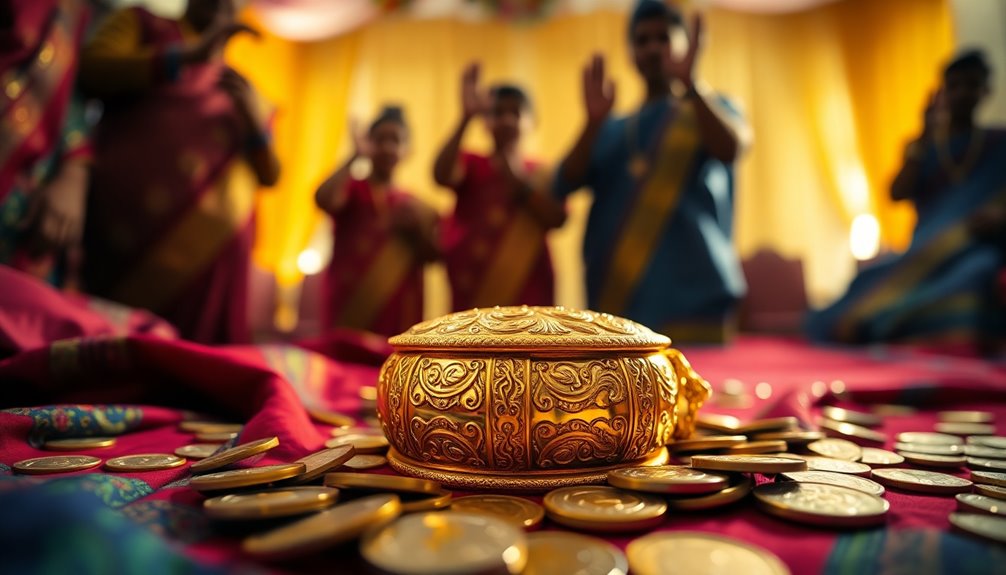
Throughout different cultures, the representation of gold extends far beyond its material value.
You'll find that gold has been used in various ways to symbolize wealth and power, often linked to divine favor and spiritual illumination. For instance, in Hinduism, gold represents goddess Lakshmi, who embodies prosperity.
Ancient civilizations, like the Egyptians, viewed gold as the flesh of the gods, using it in burial practices to signify eternal life.
Here are some exciting cultural representations of gold:
- Religious Significance: Gold has been used in sacred artifacts and ceremonial objects, reinforcing its divine status.
- Crowning Authority: In medieval Europe, gold adorned crowns and scepters, visually showcasing royalty's power.
- Gold Jewelry: Many cultures still create gold jewelry for special events like weddings, marking achievements and social status.
- Medium of Exchange: Historically, gold served as a trusted medium of exchange, highlighting its role in trade and economy.
Gold's cultural significance continues to shine brightly, reminding us of its rich history and enduring allure in our lives today!
Spiritual Symbolism of Gold

In many spiritual practices, gold serves as a powerful symbol of illumination and enlightenment, representing divine wisdom and a higher state of consciousness. When you think of gold, imagine it shining brightly, just like the light of understanding! This light helps guide you on your journey toward spiritual enlightenment.
Gold is often found in sacred objects, showing its importance in many religions. For example, Tibetan Buddhist robes are adorned with gold to connect with sacred teachings. In Hinduism, gold represents purity and is linked to goddess Lakshmi, who embodies prosperity and spiritual wealth.
When you see gold in religious artwork, it often depicts heavenly domains, reminding you of the divine presence. This makes gold a symbol of eternal life, encouraging you to seek spiritual truths.
It invites you to explore deeper meanings and higher consciousness.
Economic Importance of Gold

Valued for its unique properties, gold has long served as a cornerstone of economic systems worldwide. Throughout history, it's been recognized as a superior store of value, often even more than silver. Ancient civilizations first established its worth, and the Kingdom of Lydia was the pioneer in coining gold around 643–630 B.C., paving the way for trade and economic development.
Here are some key points about gold's economic importance:
- Gold Standard: Linking currency to gold reserves created a stable world economy in the mid-19th century.
- Wealth and Financial Security: Gold is a lasting symbol of wealth, cherished for its ability to retain value.
- Economic Uncertainty: Many see gold as a hedge against economic instability, especially during tough times.
- Gold Rushes: The 19th-century rushes in places like America and Australia encouraged exploration and settlement, boosting economic growth.
In contemporary markets, gold remains a valued asset. Its role as a store of value endures, highlighting its lasting importance in our financial systems. Additionally, investors often employ risk management strategies to protect their wealth during periods of market volatility.
Gold continues to shine brightly, influencing economies across the globe!
Artistic Expressions of Gold
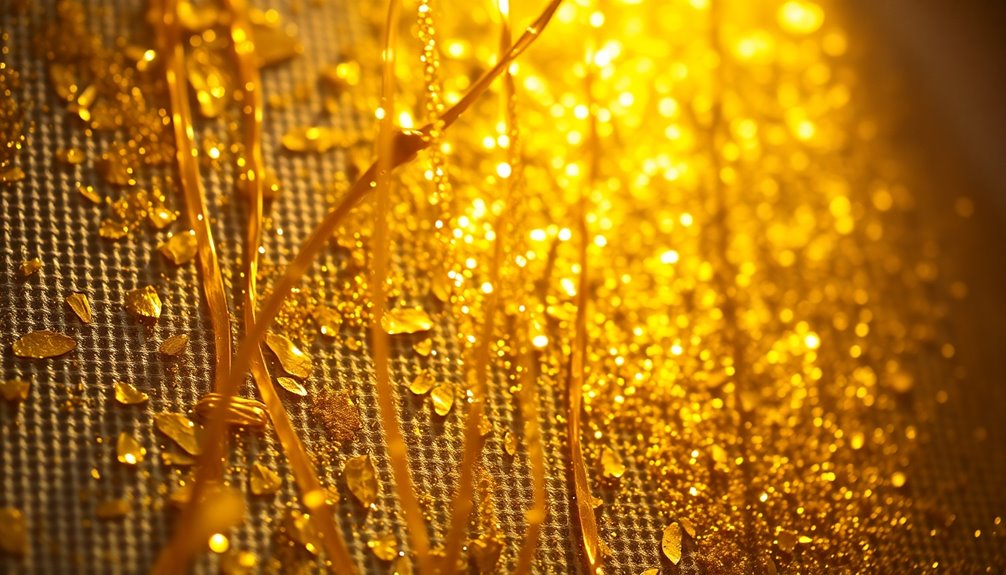
Gold's significance extends far beyond its economic value, permeating the domain of artistic expression. Throughout human history, gold has been used to create stunning works of art that captivate our imagination.
Artists often apply gold leaf to enhance the radiant beauty of divine figures, making them shimmer in ways that evoke feelings of sacredness. Just think about civilizations such as Egypt, where gold played a key role in rituals and ceremonies.
The symbolic meaning of gold stretches into literature too. In stories like the Greek myth of King Midas, gold represents both the allure of wealth and the dangers of greed.
Alchemical traditions see gold as a symbol of spiritual transformation, representing the quest for purity and perfection.
Today, we still see gold's aesthetic appeal in modern design and fashion. It symbolizes luxury and status while reminding us of its rich history.
Whether in sculptures, ceremonial artifacts, or contemporary decor, gold continues to inspire creativity. By embracing its beauty and symbolism, you can appreciate how this precious metal brings joy and meaning to artistic expressions around the world.
Frequently Asked Questions
What Is the Spiritual Meaning of Gold?
Gold has a special spiritual meaning! It represents purity and wisdom, shining brightly in many religions.
When you see gold, think of enlightenment and divine knowledge. In some cultures, like Buddhism and Hinduism, it symbolizes blessings and spiritual wealth.
Gold also reminds you of heavenly places and sacred times, such as the "golden age."
What Is the Deeper Meaning of Gold?
Gold's deeper meaning goes beyond its shiny appearance. You might think of it as a symbol of dreams and aspirations.
People have always seen gold as valuable, representing success and achievement. It's often linked to purity and goodness, shining brightly in both nature and art.
When you see gold, it can remind you of your own potential and the amazing things you can achieve in life. Isn't that an inspiring thought?
What Is the Symbolic Representation of Gold?
You might think gold's just a shiny metal, but it represents much more! It stands for purity, excellence, and even nobility.
When you see gold, you're reminded of generosity and compassion, like saying someone's "good as gold." In many cultures, it symbolizes wealth and authority, often adorning crowns and sacred items.
Gold also connects to high moral standards, reminding us of the importance of treating others well. Isn't that fascinating?
What Does Gold Symbolize in Life?
Gold symbolizes many wonderful things in life! It often stands for wealth and success, making people feel proud and accomplished.
When you think of gold, you might picture shiny trophies or medals, celebrating achievements. In a deeper sense, gold also represents purity and goodness, reminding us to be kind and generous.
Plus, its lovely color shines brightly, evoking feelings of joy and luxury. So, gold's not just pretty; it carries special meanings too!
Conclusion
So, next time you see gold, think about all the amazing meanings it holds! From its rich history to its spiritual power, gold shines bright in every culture. It's not just a pretty metal; it's a symbol of wealth, beauty, and even hope. Imagine how it connects people across the world! Now, as you explore your own life, consider what gold represents for you. What treasures might you discover in your own journey?
Under Kirsti’s gentle guidance, each insight and interpretation is thoughtfully crafted to uplift, educate, and encourage personal transformation. Whether you’re a dedicated seeker on a lifelong spiritual quest or taking your very first step into the mystical, we offer a wealth of knowledge and supportive community to illuminate your unique journey.
-

 Angel Number4 weeks ago
Angel Number4 weeks ago111 Angel Number Pregnancy: Divine Signs for Expecting Mothers!
-

 Dreams Meaning4 weeks ago
Dreams Meaning4 weeks agoYellow Eyes Dream Meaning: The Bright Significance Behind the Golden Gaze!
-

 Dreams Meaning4 weeks ago
Dreams Meaning4 weeks agoDreams About White Snakes: The Hidden Messages in Your Nightly Visions!
-

 Angel Number4 weeks ago
Angel Number4 weeks ago33333 Angel Number Meaning: Decoding the Triple Power Symbol!
-

 Dreams Meaning4 weeks ago
Dreams Meaning4 weeks agoSeeing Someone With Red Eyes in a Dream: the Powerful Symbolism Revealed!
-

 Dreams Meaning4 weeks ago
Dreams Meaning4 weeks agoSeeing Someone With Black Eyes in a Dream: the Deep Symbolism Unveiled!
-

 Dreams Meaning4 weeks ago
Dreams Meaning4 weeks agoDream About Blue Eyes: Decoding the Calm and Clarity in Your Visions!
-

 Symbolism4 weeks ago
Symbolism4 weeks ago00 Number Meaning: Exploring the Mystical Significance of Double Zeros!






